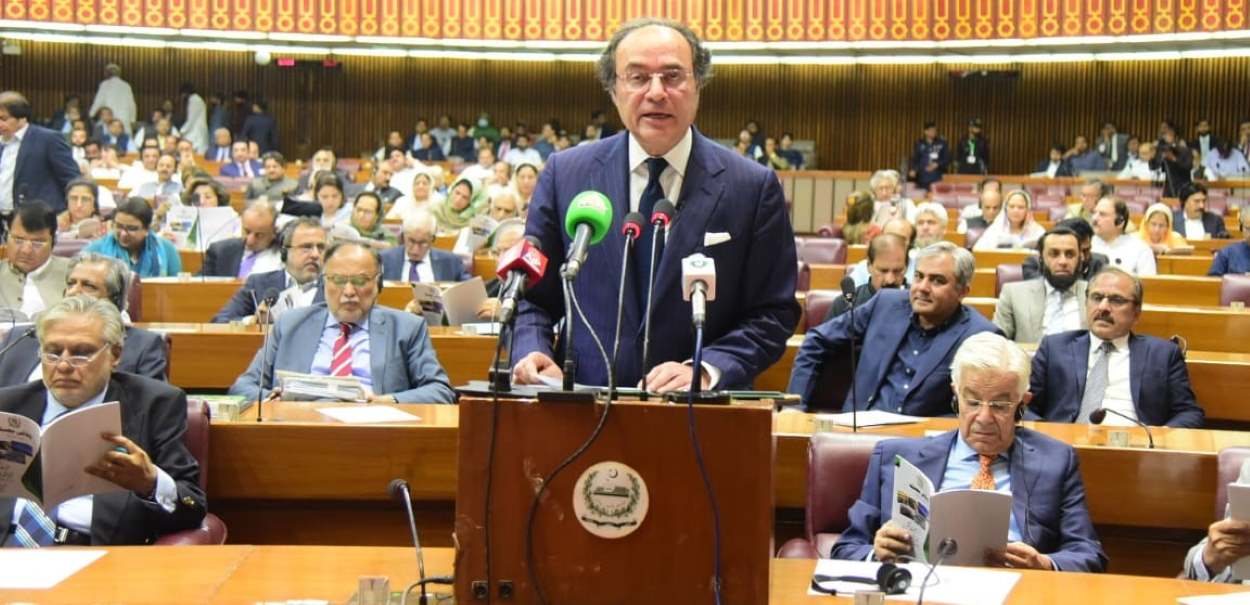Finance Minister Muhammad Aurangzeb presented Pakistan’s Budget 2024-25 in his debut speech at the National Assembly.
In his opening speech, he discussed a long-term loan deal with the International Monetary Fund (IMF), vital to Pakistan’s economy. The loan is crucial despite the dire need for relief among the financially burdened populace.
The current government faces a tough balance between maintaining popularity and ensuring economic stability amid challenging economic conditions.
This year’s budget aligns closely with IMF prerequisites to secure necessary bailout funds.
During the budget presentation, opposition from the PTI-backed Sunni Ittehad Council disrupted proceedings. Aurangzeb praised the government’s economic achievements over the past year despite this.
Economic Forecasts and Tax Revenues
He forecasted a GDP growth of 3.6% and a decrease in inflation to 12% for the upcoming fiscal year. The budget deficit will likely be 6.9% of GDP, with a primary surplus projected at 1%.
The Federal Board of Revenue (FBR) is set to collect Rs12,970 billion in taxes, marking a 38% increase from the current fiscal year.
The non-revenue target is Rs3,587 billion, with total federal expenditures projected at Rs18,877 billion. Interest payments alone will consume Rs 9,775 billion.
Aurangzeb highlighted a significant drop in inflation to nearly 12% in May. This reduction benefitted the cost of essential commodities.
Stability in foreign exchange reserves was also noted, along with a recent cut in the interest rate by the State Bank of Pakistan (SBP), evidencing efforts to control inflation.
Public Sector Development Programme (PSDP)
The Public Sector Development Programme (PSDP) is crucial in national development and welfare. The largest PSDP in history, valued at Rs1,500 billion for 2024-25, focuses on infrastructure, with 83% allocated to ongoing projects.
The PSDP also allocates significant funds for basic infrastructure development. A 59% fund allocation is proposed for this sector.
Social sector development will receive 20% of the PSDP funds. Regional development initiatives will see 10% of the funds directed to districts merged into Azad Jammu and Kashmir, Gilgit Baltistan, and Khyber Pakhtunkhwa.
Aurangzeb emphasized that the PSDP prioritizes projects that address water resources, transportation, communication, and energy needs. Some of these projects, aided by foreign support, aim to be completed within the fiscal year to aid the economy.
New projects under the PSDP will support exports, enhance production, and promote competitiveness. These initiatives focus on digital infrastructure, industrial development, and innovation.
The government acknowledges the private sector’s role in economic growth, encouraging private investments through various support mechanisms.
Significant funding has been set aside for infrastructure in the upcoming fiscal year. This includes substantial allocations for the energy, transport, water, and housing sectors.
Tax Reforms and Social Welfare
The finance minister also proposed tax reforms, including unchanged tax slabs but adjustments in rates for non-salaried individuals and real estate transactions. These reforms aim to align with international standards and enhance economic documentation.
The Benazir Income Support Programme (BISP) will continue providing aid to vulnerable segments, with plans to expand its reach and increase cash assistance.
Climate Change Initiatives
Efforts to tackle climate change were also outlined. To attract global climate finance and reduce carbon emissions, the revival of the Pakistan Climate Change Authority and the development of a National Finance Climate Strategy by November are planned.






